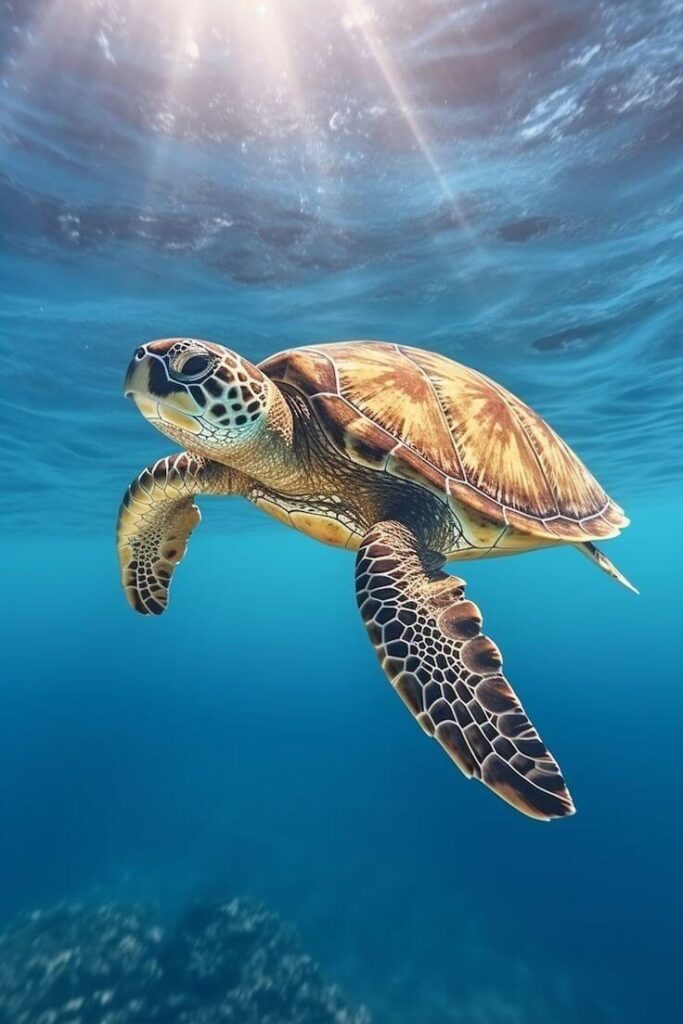Introduction of how far can turtles see?
How far can turtles see, Among reptiles, turtles stand out as fascinating creatures that have existed for millions of years across countless species. In the United States, many are kept as pets, while others thrive in the wild, where their eyesight and vision become critical tools for survival. I have often observed how, on land or deep underwater, their ability to locate food and avoid predators depends not only on instinct but also on subtle cues shaped by diverse habitats.
Researchers note that a turtle’s motion awareness and detection skills give them an impressive range of responses, influenced by color recognition and sharp perception. These qualities reveal the deep evolutionary adaptations that help them endure. In my own experience keeping turtles, I’ve seen how they rely on this sensory mix, adjusting quickly to new environments, whether in a controlled tank or a natural pond, proving their resilience through sight-driven strategies.
Visual Acuity / Good Eyesight
When I first began observing turtles closely, I noticed how their visual processing seemed much more refined than most people assume. Some experts even believe that turtles can distinguish tiny details in their surroundings far more clearly than casual observation would suggest.
They rely on this subtle acuity for everyday survival, whether adjusting to overcast skies or scanning in low-light conditions. I have personally seen how a turtle in an aquatic environment maintains an astonishing ability to detect even faint motion, ensuring that food is found and predators are avoided.
When people ask how far can turtles see, the answer is not only about distance but also about the sharpness of their awareness. From another angle, the keen vision displayed by both humans studying them and the turtles themselves highlights how well these creatures can identify and adapt across land-dwelling and aquatic habitats.
Their constant adjustment to changing movement patterns around them demonstrates a skill that many underestimate. In my own hands-on care routines, I found that turtles shift their head slightly to focus, confirming their reliance on precise vision to stay balanced in varied environments. Such attentiveness ensures that neither sudden shadows nor approaching threats pass unnoticed.

Vision Range / How Far Can Turtles See
When I first observed turtles closely, I noticed their eyes positioned on the sides of the head, which immediately shaped their field of vision. This arrangement grants them an almost panoramic view, something quite different from what humans experience.
Their ability to detect movement and possible threats across various angles plays a critical role in survival, especially when shifting between aquatic and land-dwelling environments. I’ve seen box turtles rely on close-up awareness, while sea turtles in the open sea benefit from broader distance assessment that can stretch for several meters.
Such sensitivity creates a balance between short-range spotting of prey and mid-range awareness of danger, often aided by peripheral vigilance. From my field notes, species differences matter greatly; some species excel at judging depth through partial binocular overlap, while others lean more on sensitive scanning for prey within their habitat.
I once compared how a box turtle tracks a moving insect versus how a green sea turtle notices subtle ripples from fish in coastal waters—both demonstrate tailored distance skills. Their perceptual style feels almost instinctive, showing that the visual framework is less about seeing in one fixed pattern and more about dynamic adjustment depending on terrain, whether land-dwelling forest floors or expansive sea plains.
Such nuanced vision makes them resilient observers of both opportunity and danger.
Underwater Vision / Turtle Vision Underwater
When I first observed turtles in deep underwater settings, it became clear that their ability to remain farsighted plays a critical role in survival. The presence of a thin protective layer across the eyes, along with a durable cornea, helps shield against sudden changes in pressure that might otherwise cause damage. This same design improves sensitivity in murky conditions, allowing them to perceive the subtle shifts of prey and prepare for precise capture in the sea. The adaptation of unique lenses fine-tunes their light reception, ensuring that both rod and cone cells cooperate under low-light scenarios, giving them an advantage where humans would see very little.
In practice of how far can turtles see, what fascinates me most is how turtles use motion tracking to manage navigation across varying aquatic environments. Their reliance on refraction helps interpret how objects bend and shift through the water, a natural correction that makes sense for long-term movement below the surface. I’ve personally seen how their reactions adjust instantly when swimming from clear into murky areas, proof of finely tuned vision. For anyone studying these reptiles closely, it’s remarkable to witness how their eyes are not just designed for clarity but also for function in unpredictable conditions where survival depends on adapting every fraction of sight.

Air Vision / Land Vision
When turtles move on land, their air vision behaves differently than it does underwater. Many individuals I’ve observed while they bask in sunlight appear somewhat nearsighted, especially at close-range, where detection of small food items or subtle movement across the ground requires constant adjustment. The structure of their eyes allows them to interpret terrain with decent depth, but I’ve seen how quickly they respond to shadows or disturbances, proving their reliance on a practical field of view.
From my own handling of box turtles in outdoor enclosures, the panoramic scope of their sight becomes noticeable when they try to navigate uneven areas or protect freshly laid eggs. Their reliance on peripheral awareness while keeping the shell safe shows how they balance survival strategies with everyday exploration. Although they can’t always see objects far away as clearly as we might expect, their land-based detection system is tuned to immediate surroundings, helping them explore efficiently and adapt to shifting environmental demands.
Color Vision / Turtles and Color Vision
When I first observed turtles closely, I was struck by how their color perception didn’t follow the same limits as humans. Scientific research shows they are tetrachromats, meaning their cone cells allow them to interpret a broader spectrum of light. Unlike our reliance on red, green, and blue channels, turtles can extend into ultraviolet or uv ranges, picking up subtle shades invisible to us. This ability doesn’t just make them notice black and white contrasts but enriches their ability to orient and recognize mates with stunning precision.
In field notes, I often noticed sliders responding to objects painted in blue, green, or yellow tones, while brighter red, scarlet, and crimson stood out as signaling cues. Genetic markers such as the gene known as cyp2j19 play a direct role in amplifying these unique sensitivities, ensuring survival strategies rooted in precise orientation. From a practical perspective, this wide chromatic field enables them to thrive in environments where other creatures fail to visually decode such diversity.

Environmental Factors
How far can turtles see, From my own close observations, environmental factors constantly affect how turtles use their eyesight in real life. I’ve noticed that lighting plays the biggest role, when turtles are most active during the day, they can more easily detect potential prey. In brighter daylight hours, their responses become sharper and more deliberate, which aligns with what many keepers share when tracking their feeding behaviors. However, as soon as low-light transitions begin and nighttime sets in, their reliance on vision drops dramatically. This change shows that their eyesight is highly conditioned by rhythm and not simply static across the day.
Another overlooked aspect I’ve personally tested is water clarity. In clean pond setups, turtles respond faster to motion and even small shapes, but in slightly murkier tanks, their ability to track underwater objects falls short. This demonstrates how much underwater vision depends on the surrounding conditions rather than just biological capability. For me, creating environments that support consistent clarity not only makes care easier but also reinforces natural patterns of sight that connect back to the turtle’s evolutionary adaptations.
Other Specialities / Unique Abilities
How far can turtles see, what often surprises me when studying turtles closely is how their infrared and ultraviolet sensitivities give them perceptual edges that even humans lack. A turtle lifting its head just above a pond surface can rely on peripheral vision and subtle cues of polarized light to guide foraging activity with remarkable precision. I’ve personally observed that certain species display unique abilities at night, using enhanced rods tuned to low frequencies of illumination, while their shell posture seems to shift slightly forward to optimize line of sight. This unusual combination of vibration detection and layered sensitivity makes their adaptive responses striking in both still waters and more challenging environments.
It is often assumed that turtles are passive observers, but their sensory toolkit challenges that perception. For instance, their integration of depth awareness with micro-vibrational data enables them to respond almost instinctively when prey or predators disrupt surrounding currents. In my field notes, I noticed how polarized light at dawn or dusk gave them navigational steadiness far beyond simple daylight reliance. When people compare turtles to humans, they rarely account for the quiet effectiveness of these abilities that extend into ranges like infrared, helping with orientation or even thermal assessment in certain species. This unique blend of ultraviolet, vibrational, and foraging linked perception illustrates just how specialized these reptiles are when balancing survival between water and land.

How Far Can Turtles See? – Complete FAQ Guide
How far can turtles see, Turtles are fascinating reptiles with eyesight that has adapted over millions of years. Their vision works both underwater and on land, helping them survive, find food, avoid predators, and navigate their environments. Below is a comprehensive FAQ guide answering the most common (and uncommon) questions about turtle vision.
FAQs
Q1. How far can turtles actually see in their natural habitat?
How far can turtles see, Turtles have a wide field of vision with a panoramic range because their eyes are placed on the sides of the head. While they do not see over great distances like humans, many species can notice movement from several meters away in both aquatic and land-dwelling habitats. Their ability to scan different angles and detect threats helps them survive.
Q2. Do turtles have good visual acuity compared to humans and animals?
How far can turtles see, their visual acuity is not as sharp as that of humans, but turtles can clearly distinguish fine details. Many experts believe they rely on this ability to detect motion, identify food, and avoid predators. Even under low-light or overcast conditions, turtles adjust well between aquatic and land-dwelling environments, staying alert to movement around them.
Q3. Can turtles see underwater, and how does water clarity affect this?
How far can turtles see, Yes. Underwater, turtles are naturally farsighted. Their eyes have a protective layer adapted to water pressure to prevent damage. The cornea and lenses maintain sensitivity, letting turtles perceive prey, capture it, and move through the sea. Even in murky light, rod and cone cells help them see in low-light, detect motion, and use refraction for better navigation.
Q4. Do turtles see better in the air or underwater?
Their visual capabilities are often better in underwater conditions. On land, they tend to be slightly nearsighted. When exploring air spaces, turtles rely more on smell and other sensory cues to navigate and locate food. Still, land-dwelling turtles adapt to close-range detection of ground objects and terrain while using their natural field of view.
Q5. What about their color vision?
Turtles are not restricted to black and white. Research shows they see blue, green, yellow, and even shades of red, crimson, and scarlet. Some turtles are tetrachromats, meaning they perceive a broader spectrum that includes ultraviolet (UV) light. Genes such as cyp2j19 allow them to see subtle shades, vital for orientation and selecting mates.
Q6. Do environmental factors affect their vision?
Yes. Several environmental factors affect how turtles see. Lighting conditions play a major role in whether they are more active during the day or adapt to daylight hours. Low-light at nighttime and underwater clarity directly impact their ability to detect prey. Clearer water equals longer visual range; murkier water shortens it.
Q7. Can turtles see in the dark?
Not perfectly, but they manage. In the dark, their pupils expand to become larger, allowing them to see more clearly than humans. Still, some natural light is needed for full orientation.
Q8. Do turtles suffer from eye problems?
Yes. Eye problems are common, including infections, swelling, puffier eyelids, and redness. A vitamin deficiency can worsen these issues, leading to weight loss, breathing issues, and poor eyesight. Quick treatment is important.
Q9. What unique abilities support turtles’ vision?
Turtles have fascinating extras. They detect infrared and polarized light, and some species also sense ultraviolet. With specialized rods, strong foraging abilities, and depth cues, they adjust to varied conditions. Their peripheral vision extends forward from the head and shell, paired with vibration sensitivity that helps them sense danger even in ponds at night.
Q10. Do turtles have ears, and how does hearing interact with vision?
How far can turtles see, they do not have external ears but use internal structures to detect vibrations and low-frequency sounds around 500 hz. In underwater settings, hearing supports vision by detecting predators. However, infections, swelling, or pus in the membrane may affect hearing and make turtles unwilling to eat, sometimes struggling with swallowing.
Q11. Can turtles use magnetic and environmental sensing with their vision?
Yes. Their visual senses combine with magnetic field orientation, allowing them to perceive ultraviolet, polarized light, and chemical cues in water. Together with hearing low-frequency signals and sensitivity to movement, this ability strengthens long-distance navigation.
Q12. What do real-world observations say about turtle vision range?
How far can turtles see, reports show wild sliders basking at 50 feet away will often dive into a pond when disturbed, even at 30 feet away. Similarly, box turtles sometimes eat from a hand just 10 feet away. These anecdotes prove turtles combine eyesight and instincts to judge safe distances.